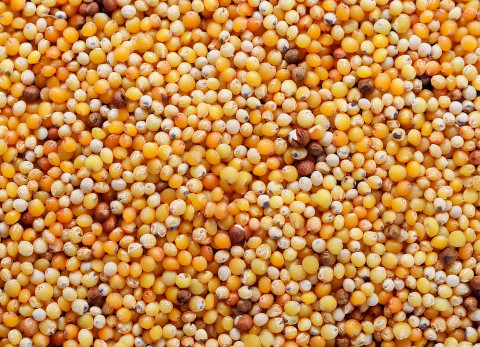Millet

Millet
Other Experts:
Learning from nature: Deciphering millet-microbiome communication for sustainable crop production
Foxtail millet and its wild ancestor green foxtail
Foxtail millet (Setaria italica) is one of the earliest domesticated crops, predominantly cultivated in the arid and semi-arid regions of Asia and Africa. Over the past two decades, the Setaria system, encompassing both foxtail millet and its ancestor green foxtail (Setaria viridis), has emerged as a model system for studying grass genetics and biofuel production. Foxtail millet is also regarded as a C4 model plant for both fundamental and applied research, and has the potential as a genomic resource to improve agronomic traits of both C4 and C3 crops.
Compared with other C4 panicoid grasses, such as maize and sorghum, foxtail millet and green foxtail have several advantages, including a shorter life cycle, smaller seed size and compact genomes, which facilitate genetic transformation. Moreover, their remarkable tolerance to abiotic stresses, including drought, salinity, and low nutrient availability, along with their nutritional value and potential health benefits, have made them a focus of scientific study.
However, the mechanistic understanding of how the microbiome contributes to foxtail millet's functional traits remains unclear. To address this, we employed two approaches: first, investigating the assembly and function of the microbiome by studying green foxtail in its natural habitat to identify diverse microbes shaped by harsh environmental conditions (e.g., low water, poor soil, pathogen pressure) (Figure 1); and second, comparing the microbiome and plant phenotypes (e.g., root traits, metabolome) between wild and domesticated foxtail millet to explore "missing" or potentially beneficial microbes in domesticated cultivars (Figure 2).
The goals of our research
- Identify and verify the functions of the potential beneficial microbial taxa from green foxtail in its natural habitat via both culture-dependent and culture-independent methods.
- Investigate the functional traits of beneficial bacteria and yeast associated with green foxtail.
- Decipher the molecular and chemical signaling mechanisms underlying foxtail millet-microbiome interactions during domestication.
- Uncover the potential contributions of "missing microbes" to plant growth and health.
The hidden microbiome of wild ancestor green foxtail (Xiaoyu Zai, PhD candidate, CAU)
- We sampled the leaves and rhizsophere of wild green foxtail S. viridis populations at the heading developmental stage at 7 sites along a latitudinal gradient in China. Our analysis revealed that variations in soil parameters, climatic conditions, as well as plant genetic distances were significantly correlated with differences in bacterial and fungal community compositions (Figure 3). These findings suggest that both environmental factors and plant genetics shape the structure of the phyllosphere microbiome in green foxtail.
- Specific bacterial genera (Bacillus, Pantoea, Methylobacterium) and yeast genera (Vishniacozyma, Filobasidium, Sporobolomyces) were identified and selected for the design of synthetic microbial communities (SynComs). These SynComs effectively protected domesticated foxtail millet from leaf infections by the fungal pathogen Alternaria alternata (Figure 3). This demonstrates the potential of harnessing natural microbial communities to enhance plant immunity and resilience against disease.
Co-evolution of foxtail millet and its microbiome: the impact of domestication and missing microbes (Mingxue Sun, PhD candidate, CAU & WUR & NIOO) - In this study, we investigated the rhizosphere and endosphere microbiomes of 16 cultivars, representing various wild and domesticated stages, using 16S and ITS amplicon sequencing. Subsequently, we integrated metagenomic and metabolomic analyses to explore functional mechanisms that may validate the co-evolution between foxtail millet and missing microbes (Figure 4).
- Our findings revealed that domestication and plant genotypes exert a stronger influence on bacterial and fungal communities in the root endosphere compared to the rhizosphere. This suggests that the domestication of foxtail millet has applied significant selective pressure on its root microbiome.
- Wild cultivars displayed higher SRL (Specific Root Length), which correlated with specific ASVs of Devosia, Nocardioides and Allorhizobium-Neorhizobium-Pararhizobium-Rhizobium. Interestingly, these ASVs appear to be depleted in the root endosphere along the domestication gradient. Collectively, these findings shed light on understanding the co-evolutionary trajectory between foxtail millet and its microbiome during domestication.
- Ongoing metagenomic and metabolomic analyses aim to elucidate the molecular and chemical signaling mechanisms driving interactions between root exudates and the missing microbes.


